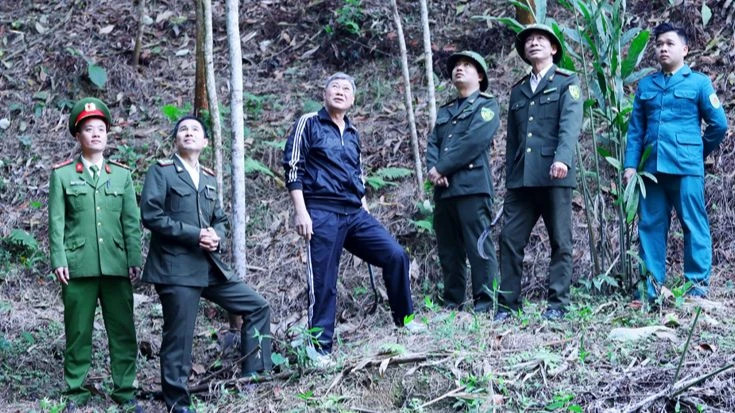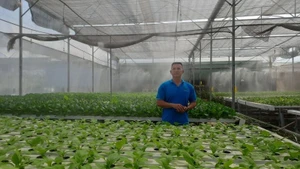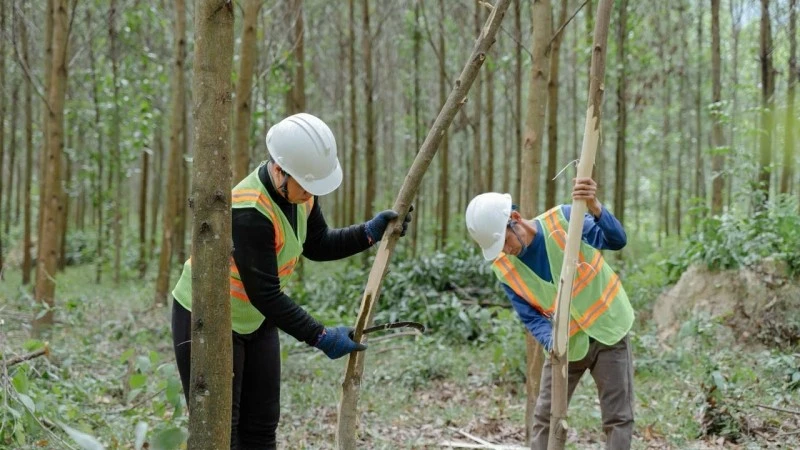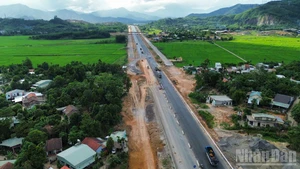According to the Ministry of Agriculture and Environment, over 3.2 million hectares of forest allocated to commune-level people’s committees are providing livelihoods for people under the forest canopy, significantly contributing to the goal of having over 50% of the forestry workforce made up of ethnic minorities living in forested areas by 2030.
At the same time, the aim is to raise average income to 1.5 times the current level by 2030 and to double it by 2050 compared to 2025 levels.
Livelihoods from forest
Located nearly 70km from the centre of Thai Nguyen City, the upland commune of Binh Long in Vo Nhai District is currently in a peak period of forest patrols and wildfire prevention. Early in the morning, Tran Tuan Hoi prepares his belongings for a patrol, including a machete, axe, lighter, raincoat, packed rice, water bottle, a small cookpot, and some fruit picked from his garden. As the chairman of the Thong Nhat Agroforestry and Environment Cooperative, Hoi often joins his specialist team to patrol forest areas bordering Huu Lung District, Lang Son Province during such critical periods, promptly detecting any violations or encroachments.
Like Hoi, Luu Van Sinh, a person of the Nung ethnic group, is the leader of a forest protection team and lives with his family near Binh Long Forest. To him, the forest is like flesh and blood, a priceless asset that he and fellow cooperative members have been striving to safeguard for more than a decade. Each patrol along the forest boundary with Lang Son Province stirs in him the same emotion he felt when he first joined the forest protection cooperative.
“In the past, transportation was difficult, with only dirt roads that were dusty in the dry season and muddy during the rains. Life was so hard that many had to leave the village for cities or go abroad to seek jobs. Since joining the cooperative, becoming a forest protector, and receiving guidance in forest planting and harvesting forest produce, life has gradually improved,” he recalled.
Binh Long is an upland commune bordering Quyet Thang Commune (Huu Lung District, Lang Son Province), which makes forest protection and management even more challenging. The forest protection cooperative has a specialist team and 15 self-managed teams stationed at different forest locations, taking turns patrolling. According to Tran Quang Hung, Chairman of Binh Long Commune People’s Committee, the entire forested area in the commune has been handed over to two cooperatives under the REDD+ programme — an international mechanism to reduce greenhouse gas emissions avoid deforestation and forest degradation. This has enhanced capacity for forest management and protection. Cooperative members have also improved their livelihoods, reduced dependence on firewood, and actively participated in sustainable forest management, afforestation, and Forest Stewardship Council (FSC) certification granting, ensuring traceable wood supply and internationally recognised sustainable forest management.
Forest allocation helps stabilise livelihoods
About 3 million hectares of forest nationwide have been handed over to local authorities for management, including 290 hectares of production forest on upland soil in Binh Long Commune, over 1 million hectares of natural forest on rocky mountains, and more than 288 hectares of production forest on upland soil with FSC certification. However, according to Nguyen Ba Ngai, Vice Chairman and General Secretary of the Viet Nam Forest Owners Association, the area of forest land transferred from forestry units to localities remains modest at just over 674,000 hectares.
Localities receiving forest management responsibilities also face many difficulties due to widespread land encroachment and overlapping land use rights. Transferred forest land is often unsuitable for management and production organisation because majority of it consists of barren hills with degraded or eroded soils, and is located in areas with poor transport access. Many forest records are sketchy or non-existent, with unclear boundaries on the ground.
According to information announced at a recent conference on forest land allocation in Ha Noi, more than 24,000 ethnic minority households across the country lack residential land, and over 210,000 ethnic minority households need support with production land. Production land shortages for poor ethnic minorities remain a problem in many localities. Other shortcomings also need to be addressed so ethnic communities can feel secure in protecting forests, thereby improving their livelihoods and stabilising their lives.
Some experts suggest that regulations on land contracting, such as Decree No. 135/2005/ND-CP and Decree No. 168/2016/ND-CP, the Law on Land 2024, and the Law on Enterprises, should be revised to suit practical needs. Financial support should also be considered for individuals and commune-level Forestry Boards effectively engaged in forest protection and management.
Additionally, the management mechanism should be renewed and expanded beneficiary groups to encourage ethnic minority people to participate in forest protection and development. Localities need to complete land inventories, compile lists of current land users, build usage plans for allocated land, and resolve overlapping, disputed, and encroached areas, thereby helping to promote economic development under the forest canopy for ethnic communities.
















